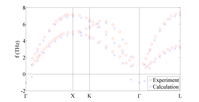Dear colleagues,
I calculated phonon spectra of some fcc crystals using response functions implemented in Abinit code. I took the frequencies directly from the output file. The obtained dispersion curves for ground states (the structures were fully relaxed) of some elements (e.g. Cu - see the attached figure) exhibit remarkable shifts to the imaginary part of frequency at gamma point. (I also calculated phonon spectra of Cu using another pseudopotential and I got only very small shift at gamma but the elastic moduli and frequencies were overestimated.) According to the paper of Xavier Gonze (Phys. Rev. B, vol. 55, April 1997), acoustic-sum rule can be broken even in the case of equilibrium state (numerical problem). In the forum I read that such frequencies can be "improved" using ANADDB. I am not sure that this can help me but I tried to use ANADDB. This utility asked me for a lot of dynamical matrices - not only those that correspond to particular directions in BZ that I'm interested in. Does anybody know if there is a possibility to define specific directions in ANADDB utility? I would like to avoid calculating such tremendous amount of dynamical matrices.
Setting of some parameters I used to calculate phonon spectra:
Cu
pseudopotential: GGA (FHI)
ngkpt: 16 16 16
nshift: 4
shiftk:
0.0 0.0 0.5
0.0 0.5 0.0
0.5 0.0 0.0
0.5 0.5 0.5
ecut: 1000 eV
occopt: 4
Thank you for your answers.
Best Regards
Petr Rehak
Institute of Engineering Physics
Faculty of Mechanical Engineering
Brno University of Technology
Technicka 2, Brno, Czech Republic
CZ-616 69
Mail: yrehak02ATstudDOTfmeDOTvutbrDOTcz
Breaking of acoustic-sum rule and ANADDB
Moderators: MMNSchmitt, gonze
